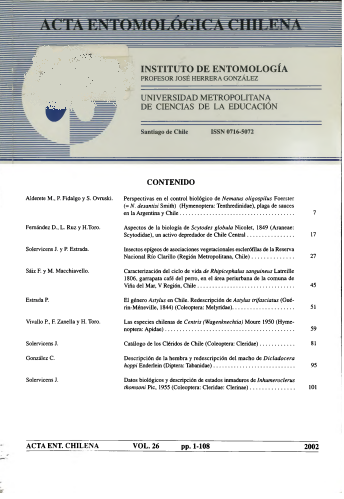Contenido principal del artículo
jul 4, 2022
Resumen
The surface insects fauna of evergreen sclerophyll shrublands from the Rio Clarillo National Reserve (Metropolitan Región, Chile) was studied. Six vegetational associations distributed between 980 and 1820 m were
sampled. Thirty-six pit fall traps, six for each association, were installed. The traps were revised monthly between May 1996 and May 1997. A total of 94.910 insects were collected, belonging to 16 orders; between
them 392 species were recognized. According to their abundance Díptera (42.08%), Hymenoptera (25.04%),
Blattodea (15.76%) and Coleóptera (8.26%) were the most important orders. After their species richness Coleóptera (58.67%) and Hemiptera (23.98%) were the most important (Díptera and Lepidoptera were excluded
of this analysis). Only 13 of the species were dominant (over 1% of abundance) and widely distributed in the
associations. 239 species were scarce, represented by 10 or less individuáis. Blattaria and Hymenoptera whose species richness is under 10% were represented mainly by dominant species and Coleóptera and Hemiptera whose species richness is high were represented chiefly by scarce species.
The association of Cryptocarya alba-Lithrea caustica obtained more than 30.000 individuáis probably
because of its greater areal size and vegetational cover.
The number of species of each vegetational association varied between 115 and 188 species. The indices of Shannon, Pielou, Hom and Jaccard showed that the entomofaunal communities were organized by
means of a reduce number of abundant and widely distributed species and a great number of scarce and
localized species, which present some variation between the vegetational associations.
The similarity in the use of habitat by plants and insects is recognized and considered an adaptation to
mediterranean climate.


